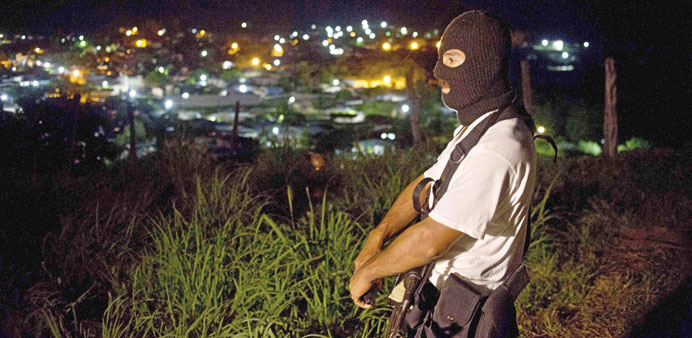By Sandra Parra, DPA/Mexico City
The violence of Mexico’s drug cartels is becoming increasingly visible: more and more mass graves are being discovered with bodies of the gangs’ victims.
Police are quite powerless to stop a wave of violence that has claimed around 87,000 lives over the past seven years, and they sometimes take a cut of the action, as well as being slain.
Over the past month, mass graves have been unearthed time and again, across Mexico.
More than 100 bodies have been found in the states of Guerrero, Sonora, Zacatecas and Morelos as well as in Jalisco and Michoacan.
Since November 9, sixty-seven bodies were found in the region between the states of Jalisco and Michoacan alone.
One improvised cemetery in the municipality of La Barca, with about 20 graves, is the largest that has been found so far.
Forensic experts clothed in white protective suits have been combing through the sites, motivated even more by the search for two of their colleagues who disappeared in the area in early November.
Typically, the drug gangs get rid of the remains by digging mass graves and throwing in the mutilated and sometimes charred bodies.
The missing are found weeks or months later, and sometimes not at all.
Beheading is a trademark of some of the gangs. The war among the gangs for territorial control and their respective defiance of authority within their territory has claimed the tens of thousands of lives since late 2006.
The discovery of mutilated bodies has become a gruesome constant, a macabre image always running in the background in Mexico.
A few days ago, law enforcement agencies found 17 bodies on a hill in Zapopan, a suburb of the western city of Guadalajara, Mexico’s second-largest city, in the state of Jalisco.
The authorities suspect that the gang Jalisco Nueva Generacion was involved with both the mass graves in La Barca and Zapopan.
In August, the authorities found in the state of Mexico, adjacent to the capital, the bodies of 12 young people who had been kidnapped in May from a nightlife area of Mexico City.
The crimes were allegedly linked to a conflict between two rival drug gangs in the capital.
No section of Mexico is spared the haunting by the secret mass graves.
State governors keep a running tally of bodies found.
Some, like Morelos Governor Graco Ramirez, try to distance themselves from the horror, saying the crimes were committed before they took office.
Tip-offs from suspects during interrogations sometimes lead authorities to the graves.
In other cases, such as the graves in La Barca, it is local police officers who give up the information while they themselves are being interrogated.
“The most serious thing here is that those graves were found based on the interrogations that both Mexico’s Army and Navy subjected the local police officers of some Michoacan towns, too. That is, police officers who were obviously involved as accomplices in these crimes,” Javier Oliva, a professor of political and social science at Mexico’s National Autonomous University (UNAM), told DPA.
Local authorities are “fully” incapable of facing these problems, the researcher said.
The latest findings are not new.
In April 2011, more than 250 bodies were found in a mass grave in the state of Durango, while 193 more were found in Tamaulipas.
Mexico’s Attorney-General has set up a DNA bank with samples from at least 400 people who are looking for missing relatives.
More and more, the remains in mass graves are to be cross-checked with this bank.
Oliva blames local authorities for their incompetence in handling the violence of organised crime.
“In Mexico, we have had no rest from pain, and I believe that is very serious for the functioning of our country’s social system,” he said.

A member of the Citizens’ Self-Protection Police stand guard in Aguililla, Michoacan state. Citizens have resorted to forming or hiring people to prot
